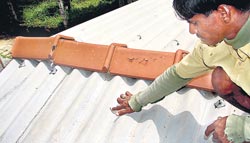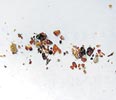
Catch a falling star
It was a quiet Sunday night in Kovinna, Andiambalama. At 9.05 p.m., 24-year-old H.T. Nadeeshani was having a bath at the well in her garden when she noticed something unusual in the western sky. A bright light, almost as large as the full moon, appeared to be moving towards her in a wide arc. Alarmed by thoughts of terrorist air attacks, she called out to her neighbour, Mrs. Renuka Jayakody. Together they watched fearfully as the glowing object drew closer, landed on the Jayakodys’ roof and vanished completely. A few minutes later the air vibrated with a loud explosion.
The next day they discovered that parts of the asbestos sheets on the roof were charred and cracked. A few pieces of rock and sand were scattered around the damaged area. Similar incidents were reported around the country that night. Several people in areas such as Puttalam, Maho and Bingiriya also noted the appearance of the bright light in the sky as well as the loud explosion. “We thought it was another air attack or the beams from the airport,” says K. Sarath, a trishaw driver in Kimbulapitiya who watched a flaming object land on a house and heard the booming sounds soon afterwards. In Campbell Place, Dehiwala, the roofs of two buildings were damaged, and a loud noise was heard. “24 asbestos sheets were broken,” says M.D. Sampath who works in one of the buildings, adding that there was no sign of what caused the damage. The strange objects that lit the night skies on June 10 have now been confirmed as meteors. “This is the first time that meteors of such magnitude have fallen in Sri Lanka,” says Dr. Chandana Jayaratne, Senior Consultant at the Arthur C. Clarke Institute for Modern Technologies, who is currently gathering data and conducting studies on the incident. The shockwaves and vibrations have been heard throughout the country, from Galle to Puttalam.
He believes that two large meteoroids entered the atmosphere, the larger one splitting into two and the smaller one into about 25 fragments. The loud explosions, he says, were some of the particles exploding, probably about 50 to 100 km above the ground. The peculiarity of this incident is that there was very little trace of the meteoroids even where extensive damage had occurred such as in Dehiwala. The meteoroid was travelling at such high momentum that all the particles must have dissolved or vaporised by the heat on impact, he explains. Residents of Andiambalama say that they had noticed unusual movement of the stars for about two weeks continually prior to the falling of the meteor. “We saw many shooting stars, the children started gathering at about 8 p.m. every night just to watch this,” says Prasanna Jayakody, adding that they even reported it to the emergency police hotline. Dr. Jayaratne however says that this has nothing to do with the falling of the meteor. |
|| Front
Page | News | Editorial | Columns | Sports | Plus | Financial
Times | International | Mirror | TV
Times | Funday
Times || |
| |
Copyright
2007 Wijeya
Newspapers Ltd.Colombo. Sri Lanka. |

